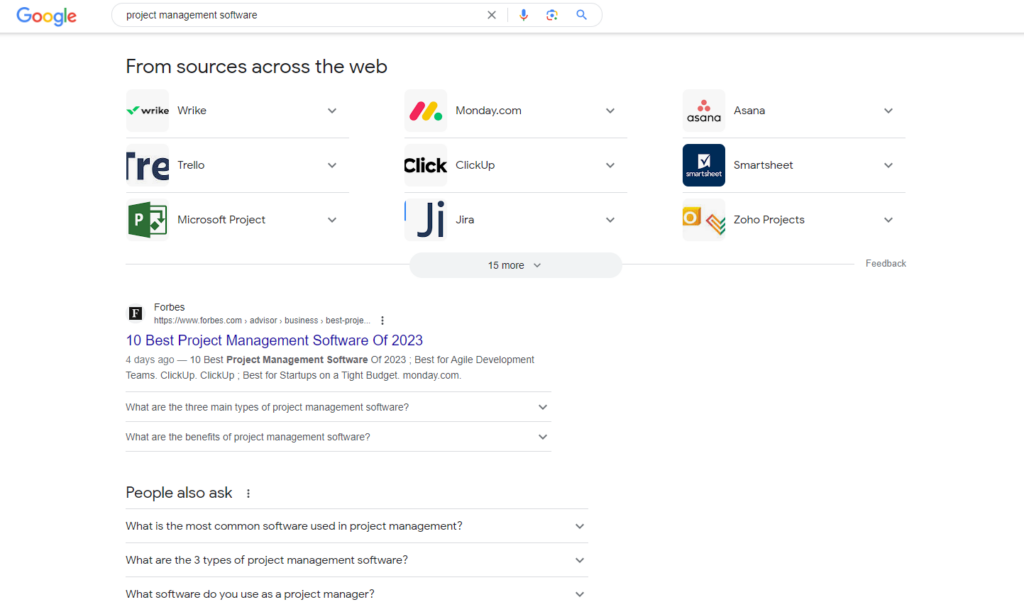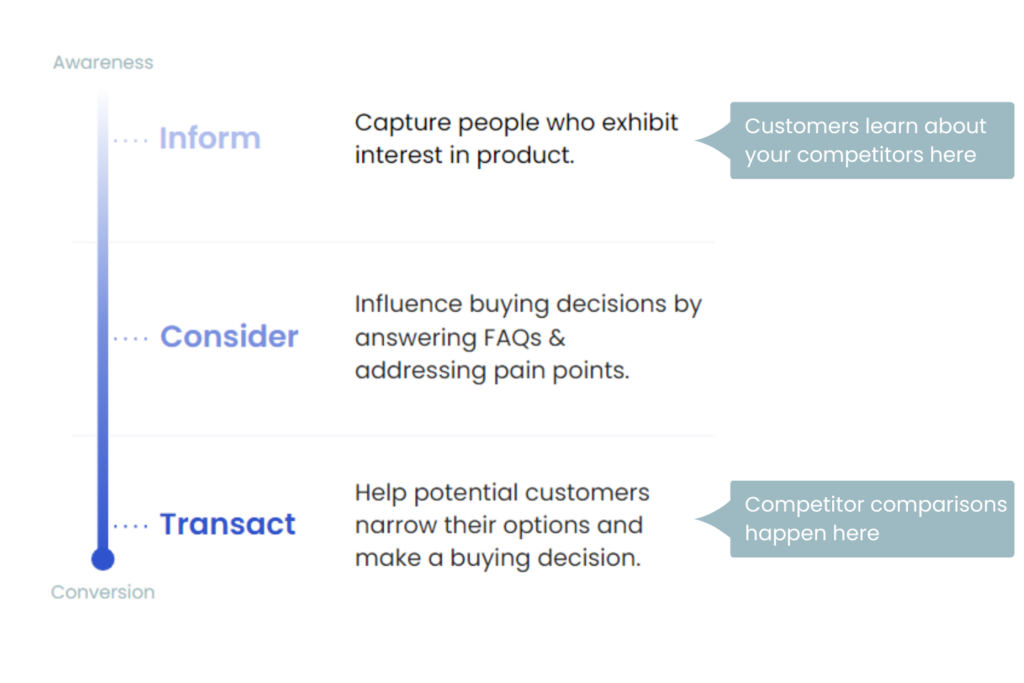Table of Contents
If you have experience doing SEO for SaaS companies, you’ve likely had to confront an annoying truth: ranking for bottom-of-funnel keywords is hard. You may have tried optimizing your landing pages, investing in technical SEO, and even building out new landing page sets with virtually nothing to show for it.
What’s worse, doubling down on these blue chip methods because they work in other verticals can lead to a huge opportunity cost. While the competition is growing, you’re standing still - or worse - losing ground. The fact of the matter is that many of the tried and true approaches to SEO that should work in theory, don’t work in practice when it comes to SaaS. Fortunately, there’s always a workaround.
In this article, we’re going to show you how competitor comparison articles, an underrated and often misunderstood tactic, can grow organic traffic and SQLs. We’ll also talk through our specific approach to competitor comparisons and share the template we use to produce the articles. By the end of the article, you should have a solid understanding of how you can leverage this type of content for your own SaaS business.

The challenges of ranking for high-purchase intent SaaS keywords
We’ve talked before about how the unique challenges of SaaS SEO have led to a proliferation of commonly-held misconceptions about the best ways to approach it. It’s these challenges that make a tactic like competitor comparison articles especially useful in the SaaS vertical.
Ranking for non-brand, BOFU SaaS keywords is hard
If your SaaS product maps to keywords with even moderate levels of competitiveness, ranking for non-brand category keywords will often feel like a hopeless pursuit. This has everything to do with search intent and search engines’ goal of serving it as well as they can.
The fact is that when most users search for non-brand SaaS keywords, they don’t want to see your landing page - they want to see options from which they can choose. A menu rather than a single dish. Over the years, this has led to aggregator sites like G2 and Gartner dominating the SERPs for SaaS keywords. This is why we often employ tactics like competitor comparison articles, product roundups, and “[competitor] alternatives” articles.

Without a doubt, we’ll still recommend that our clients optimize their landing pages and sometimes build out new landing page sets, especially when there are striking distance keyword rankings to be earned. But we do so with eyes wide open, knowing there’s a good chance these pages will never produce the bulk of their leads.
The leads that come from category-level keyword rankings can be pretty underwhelming
If you do have the resources needed to rank for your company’s non-brand category keywords (and those resources are often considerable), you’ll likely encounter another potential challenge: the leads that come from ranking for these keywords aren’t always that great. The less specific a keyword is to your unique company and the pain points it solves, the lower the quality-to-quantity ratio will often be.
“Okay,” you might say, “I can deal with sifting through this giant pile of leads, even if they aren’t all perfect.” And that’s fair. But in order to build a high-performing lead-driving machine, we’ll need to leverage tactics that will yield more consistent growth over the long term.
Addressing the elephant in the room
Before we move on, let’s call out the fact that even the idea of directly comparing one’s own SaaS product to a direct competitor in the form of a blog post produces a visceral negative reaction in many. And that’s understandable. That one would intentionally advertise the existence of their competitors while potentially opening themselves up to retaliation seems counterintuitive.
But here’s the thing: in our experience, neither of those concerns end up holding much water.
The concern about advertising customers, while understandable, is based on a misunderstanding of the user journey:

While you might assume you’re introducing potential customers to your competitors for the first time, this likely isn’t the case. People searching for software are savvy and tend to do their homework before making a decision, so there’s a good chance they’ve heard of your competitors.
And besides, even if you are introducing them to your competitors for the first time, wouldn’t you rather have it be on your website than on your competitor’s or an aggregator site?
Concerns about retaliation tend to recede when we explain how we approach competitor comparisons. We’ll get into more detail below but the important thing to understand is that these are not hit pieces. While they do give our clients a chance to own the narrative, that narrative is fair and honest, supported by facts about both products. When competitor comparisons are written in a way that puts the customer first and presents information accurately, there’s little left against which to retaliate.
Our approach to competitor comparison articles
While there’s no one-size-fits-all way to approach competitor comparisons, we’ve developed a repeatable system for creating competitor comparisons that consistently get results. Below we’ll walk you through our approach to writing comparisons that actually drive meaningful conversions.
Gather a List of Competitors
Before creating comparison articles, you’ll need a list of competitors against which you can compare your brand. There are a few sources we typically use to create this list:
Our clients’ sales and marketing teams
One of the best ways in which to discover competitors is through conversations with our clients. Our clients’ sales and marketing teams are keenly aware of where they stack up in the marketplace and against which companies they’re typically competing.
They also have crucial insights into what their product does better than competitors and vice versa. Whether you’re in-house or at an agency, leverage these resources to build your list of competitors and get important context.
Keyword research
Another source for competitor options is good old keyword research. While many competitor comparison keywords will be low or zero-volume, SEO tools can help us surface many of the comparison keywords with the highest potential in terms of traffic.
To find comparison options that don’t show up in keyword research tools, Google’s autocomplete feature is a great resource for filling in the gaps.

Templatize your comparisons
While templatizing articles may sound boring or restrictive, it’s really an ideal creative constraint that helps to promote consistency and efficiency. By using a standard template for competitor comparisons, you drastically cut down on the time it takes to produce each article while ensuring you’ve covered everything you need to and nothing you don’t. It’s also helpful for potential customers who read multiple comparisons.
Use our competitor comparison template >>

Leverage the sales team
We always try to involve our clients’ sales team in our content production process. This includes doing interviews with them during our strategy development phase and sometimes for individual articles.
While some of the information in our competitor comparison articles can be found online or in the sales materials our clients give us, chatting with members of the sales team almost always yields insights that help us make our content more unique and information-rich.
Be fair and honest in your comparisons
We mentioned it earlier but it’s worth reemphasizing: the point of competitor comparison articles is not to throw shade at competitors while being overly favorable to your own product. Doing so would cause your customers to instantly lose trust, would draw negative attention from competitors and, in some cases, may prevent you from ranking for the target keywords in the first place.
Instead, we want to provide information that’s fair, honest, and accurate. Note that we didn’t say the article needs to be perfectly balanced; we still want to use comparisons as an opportunity to own the narrative and persuade potential customers. But we want to craft our comparisons in such a way that if a member of the competitor’s sales team were to read them, they’d leave thinking “Well, I can’t argue with that.”
Repurpose competitor comparison content for other channels

A common saying at Uproer is that not all content is SEO content, but all SEO content can be used for other channels. This certainly holds true for competitor comparisons as well.
To maximize the value of a competitor comparison article, we recommend our customers use them in their email campaigns and as sales collateral during the sales cycle. If someone who landed on the article via search engine would find it helpful, why wouldn’t someone who arrived via a different channel but who’s still in the same stage of the customer journey?
Real-world example: coopting competitor search volume
One of the challenges we often bump up against is a lack of search volume for “[client] vs. [competitor]” keywords. Keyword research often reveals that, unsurprisingly, most of the searches are for the bigger brands in the space. Rather than shrug our shoulders and give up on the tactic, we can employ a crafty workaround: three-way comparisons.
The idea of three-way comparisons is simple:
- Start with an existing “vs.” search term for which there is measurable volume. In most cases, this will be two larger or more well-known competitors.
- Then, we’ll insert ourselves into the conversation by adding our client to the comparison: “[competitor] vs. [competitor] vs. [client]”
By doing this, we’re coopting competitor search volume by ranking for the competitors’ comparison keywords and then positioning our client’s brand as a third alternative.
Here’s an example in the wild from one of our clients, Integrate.io:

The article successfully ranked for the target keyword, “jitterbit vs mulesoft,” while positioning Integrate.io as a viable third option.
The result? A 15% email submission rate from organic users. The three-way comparison is a great example of how to cater to existing search demand while increasing awareness of your own or your client’s brand.
Use comparisons to unlock traffic and leads
Ranking for high-purchase intent SaaS keywords isn’t always straightforward. The landscape is often extremely competitive and search volumes for non-brand category keywords are sometimes meager. This means we need to get creative with how we’re capturing traffic at the middle and bottom of the funnel, and a great way to do that is with competitor comparison articles.
While it might at first feel uncomfortable to publish an article directly comparing your product to the competition, we’d encourage you to lean into that discomfort. In all likelihood, fears around advertising for the competition, hurting your brand, or inviting retaliation are misguided if the tactic is executed well. We think the potential upside of attracting high-quality traffic and leads is worth giving it a shot.
If you’re interested in learning more about how to grow leads for your SaaS business, we’d love to hear from you. As an agency specializing in strategies for growth-oriented SaaS businesses, we have the necessary tools to help grow your funnel.

